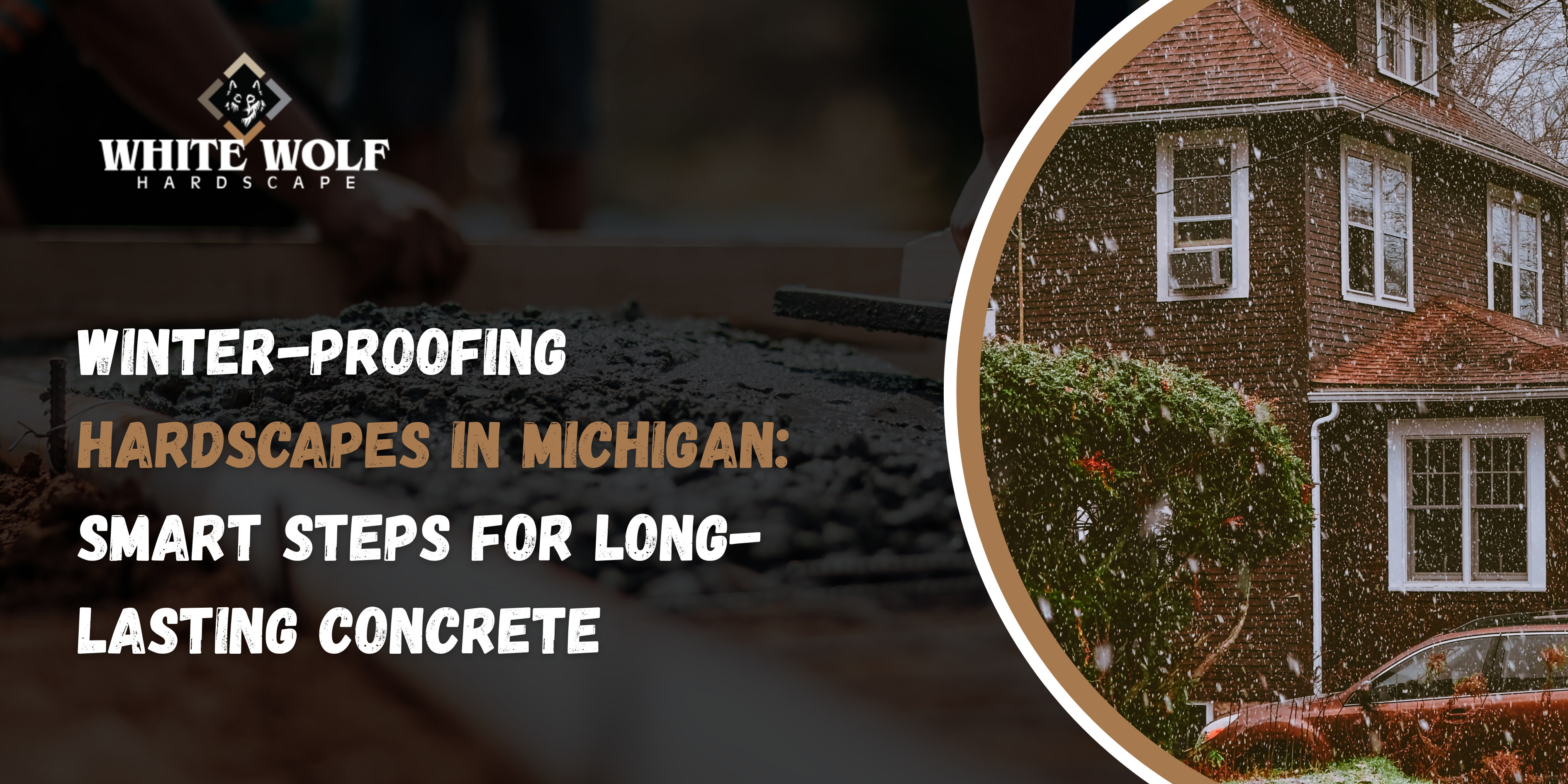Winter-Proofing Hardscapes in Michigan: Smart Steps for Long-Lasting Concrete
Michigan winters are harsh on outdoor surfaces. Freeze-thaw cycles, road salt, heavy snow, and freeze-driven ground movement put strain on patios, driveways, walkways, and retaining walls.
If you want concrete hardscapes that survive year after year, design and maintenance decisions made before the first snow matter. This post covers practical, contractor-grade guidance for winter-proofing concrete so your hardscape resists cracking, spalling, and heaving.
Start with the right design and site prep
Durability starts in planning. Score the site such that the water flows away from the concrete and does not stagnate around the sides. The lack of drainage enhances freeze-thaw damage and undermines. Prepare a stable, high-density compacted subbase (gravel or crushed stone) of appropriate dimension to the load and soil type.
Footing and slab edges in soils prone to frost in frost-prone soils should be placed at depths lower than the local frost depth, or frost frost-protected shallow foundation method should be used. Install control joints periodically so as to guide the cracking where you have some control over it, and shape the slopes with at least 1/8 to 1/4 inch per foot slopes on the runoff.
Use the right concrete mix and reinforcement
One of the key control points of winter performance is mix design. Apply a concrete with a sufficient compressive strength that is properly proportioned to the use-usually 3,500 to 4,500 psi in residential slabs, more in the case of heavy loads. Add entrainment (usually 4-7%), in order to provide the concrete with microscopic air bubbles, which relieve internal pressure during the release of water freezing and expansion.
Minimise water content to make it less permeable and prevent excessively rich mixes, which promote the formation of cracks of shrinkage. Apply adequate reinforcement. Slabs should be reinforced with wire mesh, structural elements with rebar to ensure that the width of the cracks is minimized and the pavement is left to work as a unit.
One-page winter prep checklist (essential actions)
Make sure that it is drained properly: Do not slop towards structures, and make sure there are no low spots.
Compact the subbase: 4-8 inches of well-compacted stone for walkways and more in driveways.
Indicate air-entrained concrete: Avoids damage from freeze-thaw by offering relief voids.
Control joints and reinforcement: Direct cracks and less random splitting.
Apply finish and leave to dry properly: Do not overwork the surface; when possible, leave to cure for at least 7 days.
Follow deicing best practice: This means not to use salts early in the season and to use less toxic salts wherever possible.
Plan the repairs in hot months: Repair cracks and spalls before they are forced to larger sizes by the freeze cycles.
Protect the surface with proper finishing and curing
The way the fresh concrete is completed and cured has an impact on long-term strength. Excessive troweling should also be avoided as this seals pores and traps moisture on the surface. Rather, finish to purpose, e.g., broom finish to make walkways slip-resistant, light trowel or exposed aggregate to make patios.
Wait until the concrete becomes strong. Don’t use moisture-curing, curing compounds, or protective blankets during cold weather. Early curing- Rapid changes in temperature expose it to cracking, and scheduling of pours when you can control the temperature, or insulating blankets and heated enclosures on late fall pours can prevent the problem.
Smart winter maintenance and deicing choices
The treatment of concrete during winter influences its life span. Rock salt (sodium chloride) should not be applied to new concrete; it encourages scaling and reinforcement corrosion.
Weatherstripping Calcium magnesium acetate or sand to prevent traction in the initial few freeze-thaw cycles, and clear snow off immediately using plastic-edged shovels or snowblowers to minimise surface freeze-thaw cycles. Meltwater should not be puddling on slabs, and this can be achieved by ensuring that clear standing water and gutters, and downspouts are operating.
Repair small issues early
Minor cracks and cracks on the surface are a natural thing with time; the only thing is to be able to solve the problem before the cycles increase the damage. Deep patching mortars to shallow spalls and routed-and-sealed joint cracks.
Big or structural cracks can be evaluated or repaired by a professional, and underpinning or substituting the damaged area can be performed. It is better to plan repairs during spring or summer when the best materials and curing practices are used.
Long-term planning and contractor selection
Good design, quality materials, proper installation, and maintenance will yield a long-lasting hardscape. Employ contractors that identify air-entrained mixes, recognize frost depth and local soils, and document compaction and curing procedures. Request examples and references of local projects that last through several Michigan winters.
Conclusion
Michigan winter is a challenge to a hardscape system. You can significantly eliminate the probability of cracking, spalling, and heaving by insisting on drainage, proper compaction of subbase, air-entrained mixes, proper finishing and curing, and reasonable winter maintenance.
Repair minor problems fast and select media and closing systems that are freezing-thaw. To receive expert advice on concrete specification, installation, and winterization that are specific to the county of Oakland and nearby areas, reach White Wolf Concrete.

